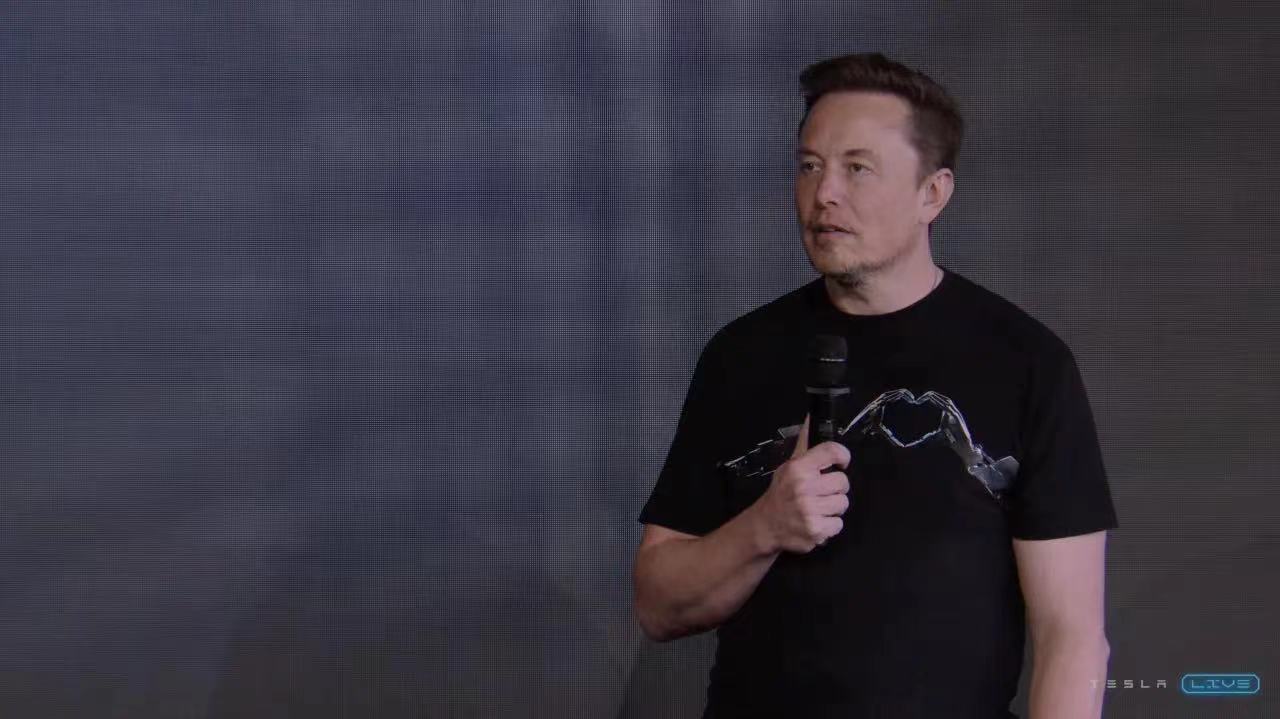For Tesla, how to implement FSD is actually a very tricky question.
After all, in Tesla’s vision, FSD (Full Self-Driving) refers to cars being able to drive in most cities without human intervention, aiming to achieve a safer driving environment than that offered by human drivers.
This vision is grand, and it has raised expectations – but it also easily invites criticism during its implementation process.
Fortunately, unlike the level classification standards for autonomous driving defined by the Society of Automotive Engineers (SAE), Tesla’s FSD has its own set of rules:
The design of the FSD Beta system follows autonomous logic, but it requires driver supervision. While the responsibility lies with the driver rather than Tesla’s system, the FSD is considered a Level 2 assisted driving system, with drivers constantly prepared to take control when necessary.
This implies that although Musk’s ambitious words have set a long-term goal for the FSD, he is also well aware that reaching that goal requires caution, an approach of “crossing the river by feeling the stones”, and avoiding any haste.
In fact, since the release of the FSD Beta, its progress has remained highly cautious.
The Challenging Journey of Testing and Promotion
When Musk first announced the FSD in 2015, even he might not have expected that the software-based FSD would undergo a difficult development cycle of five years from its announcement to its actual birth.
But that’s precisely what happened.
As a result, it wasn’t until October 21, 2020, that Musk announced the rollout of the FSD Beta test version to a very limited number of users in the United States – the first time he had released a test version of the system since announcing the FSD.
Musk’s announcement of the testing immediately sparked intense debate, followed by Tesla users who received the software upgrade demonstrating the actual performance of the FSD Beta on social media. The FSD seemed to be a big hit among Tesla enthusiasts. However, in stark contrast, Musk’s attitude towards the FSD Beta was much more sober, as he explicitly stated:
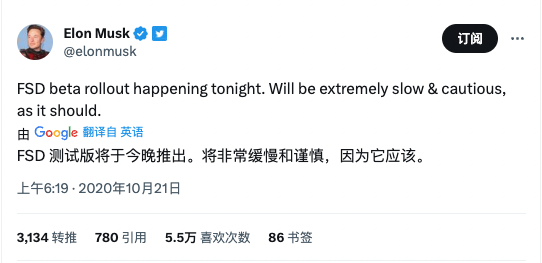
“FSD will progress very slowly and cautiously, as it should.”
Correspondingly, the American owners participating in the test were described by Musk as “expert and cautious drivers,” as only those who actively applied for Tesla’s Early Access program and passed Tesla’s “safety test score” assessment would have the opportunity to participate in the FSD Beta testing.As the testing platform for FSD, Early Access primarily aims to help eliminate errors in FSD software.
According to the update notes captured by owners who received the update, the testing version emphasizes that drivers must pay “extra caution” when using FSD Beta, as real-world driving will be much more complex, especially in blind spots, intersections, and narrow roads, “It may do the wrong thing at the worst time.”
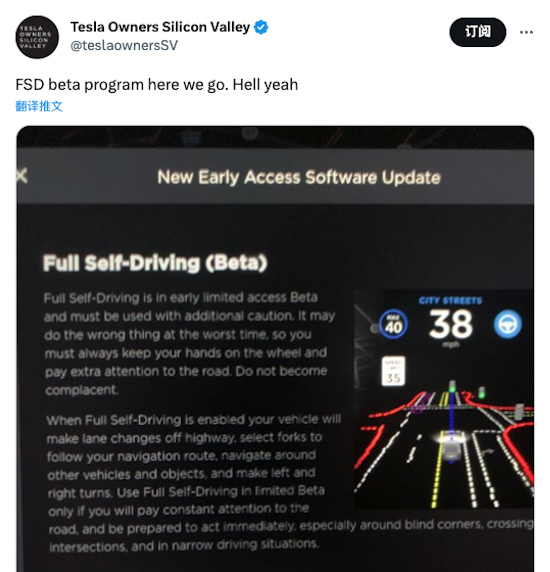
This validates precisely why Musk is so cautious.
Moreover, as the regulatory agency, the National Highway Traffic Safety Administration (NHTSA) stated that the initial launch of FSD testing demonstrates Tesla’s progress in driver-assistance systems, but regulators will closely monitor the new technology and take action without hesitation to protect the public from unreasonable safety risks.
However, these challenges and obstacles will not diminish Musk’s determination to promote FSD testing. In the earnings call the next day, Musk pointed out that more Tesla owners will receive FSD updates over time, with the goal of a “widespread release” by the end of the year.
This signifies that the journey of FSD testing promotion has officially begun.
Spiral ascent and wave-like progress
The year 2020 was exceptional for Tesla, marking its first full-year profit and the initial rollout of FSD testing. This set a positive tone for the beginning of 2021.
Under this tone, FSD made progress.
At the earnings call held at the beginning of 2021, Musk stated that nearly 1,000 owners had participated in FSD testing on public roads as of January 2021. He also mentioned that it had become routine for him to test the FSD system without intervening, predicting that FSD driving would be more reliable than humans this year.
Amid Musk’s repeated emphasis, the maturity of FSD technology remains uncertain, but the scale of testing is indeed expanding continuously.
In March of the same year, Musk announced that the number of FSD testers had expanded from 1,000 to 2,000, while also revoking some owners’ trial eligibility, reiterating the importance of focusing on the road while driving.
Musk also revealed that FSD would release its next significant version in April, discontinuing radar usage and adopting a purely visual approach, calling it “the way to real-world AI.” As a result, high expectations were given to the new version planned for April release – FSD Beta V9.0.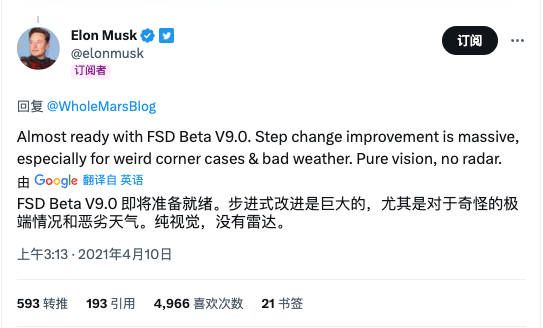
Specifically, it adopted a radical pure visual perception approach, removing the millimeter-wave radar in the new Model 3 and Model Y in the US, and replacing it with Tesla Vision’s pure visual technology based on camera detection. Due to the “significant architectural changes” in the scheme and technology, Musk believes that this version of FSD Beta has made tremendous incremental improvements, capable of handling corner cases and harsh weather conditions.
In response to questions about radar, Musk made his position on radar clear on Twitter: “remove”. This means that Tesla is shifting towards neural networks rather than programming logic for driving decisions, sparking an ongoing debate between the two approaches of pure visual and sensor perception.
However, predictably, after being delayed for three months amidst high anticipation, FSD Beta V9.0 finally arrived in July, officially rolling out to approximately 2,000 US users.
Subsequently, the testing rules also changed—12 full months after the start of FSD Beta testing, Tesla began further promoting the FSD Beta test version in the United States in October.
It is worth noting that the form of joining the test underwent a noticeable transformation, from initially having to purchase the FSD drive package and clicking the “download button” to download the latest software, to a “request button” which required assessing the driver’s driving conditions based on parameters, and then adding the driver to the queue waiting to obtain the latest software version.
Drivers need to drive for more than 100 miles and obtain a perfect score of 100 in Tesla’s safety rating system to be eligible to participate in the V10.2 version testing—this illustrates that Tesla is expanding the volume of testers while carefully testing FSD; drivers must stay focused throughout the driving process, prepared to take over at any moment.
In fact, this attitude has been repeatedly proven to be correct, as innovation does not follow a linear path but often evolves in a spiral-like upward and wave-like forward manner.
On October 24, 2022, Musk announced on Twitter the withdrawal of the V10.3 release and temporarily reverted to the V10.2 version, which was later followed by the quick release of V10.3.1 after resolving issues.
The reason for this was that some testers discovered potential risks in this version: false forward collision warnings or accidental activation of emergency brakes. Although Musk stated that this was an “expected outcome in Beta software”, it also demonstrates that drivers must concentrate as much as possible to ensure safety while providing prompt feedback for improvements.
In November 2021, the number of FSD Beta testers reached 11,700.## Proceeding with Utmost Caution, Reaching Milestones
In January 2022, according to Tesla’s Q4 2021 shareholder meeting documents, the FSD Beta program has accumulated over 60,000 testers. Elon Musk stated on the Q4 earnings call that, “In the next few months, there will be profound improvements to FSD, and I would be shocked if we cannot achieve fully autonomous driving that is safer than humans this year.”
As the FSD Beta improves, the number of testers continues to grow.
In an April TED interview, Musk told host Chris Anderson that the FSD Beta had a total of 100,000 testers, nearly a 67% increase from the 60,000 in January.
It’s worth noting that on March 26, the FSD Beta testing program began expanding to Canada. As long as owners complete the “request” process, Tesla will evaluate their daily driving, and only those with a perfect safety score of 100 will be eligible to receive the latest FSD Beta software. These facts indicate that, while the safety and technical capabilities of FSD Beta continue to grow, Tesla remains cautious.
Concerning achieving full autonomy, Musk reiterated that he is referring to a scenario where Tesla’s electric vehicles can drive in most cities without human intervention and be safer than human drivers.
Addressing the problem of continual delays, he explained that FSD has experienced “many false dawns,” with progress resembling a logarithmic curve, “sometimes rising, sometimes starting to decline, and you start getting diminishing returns.” This implies that the difficulties encountered in making progress have been far greater than anticipated: just when you think you are getting somewhere, you hit a ceiling, and have to start over.
It is evident that FSD has encountered numerous setbacks on its path to implementation.
In September 2022, when Tesla released the FSD Beta V10.69.2.2, Musk announced that over 160,000 testers in North America were participating in the FSD Beta program. At this point, drivers in the region with over 100 miles of driving history and safety scores of 80 or higher were eligible to receive the latest FSD Beta version.
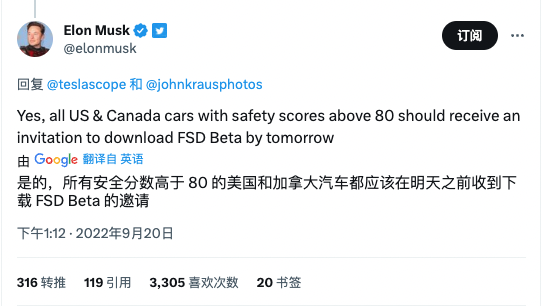
On November 24, it was a special day for Tesla owners eagerly awaiting the FSD Beta test, as Tesla officially rolled out the FSD Beta test feature to all North American FSD package purchasers. That means the FSD Beta has evolved from a small-scale Early Access test to a test for high-scoring drivers, and finally to distribution to all users who purchased the optional package. This, according to Musk, represents an “important milestone” for Tesla’s Autopilot and AI teams.At this point, it has been exactly two years since FSD Beta first began testing.
In conclusion
From the official start of testing up until now, FSD Beta has actually been “feeling its way across the river”.
After all, this is an extremely complex implementation project, involving a vast amount of work to be done in terms of technological iteration, experience enhancement, and user feedback – most importantly, it is directly related to people’s safety.
Based on this premise, it is not excessive for Tesla, as a car manufacturer, to be cautious.
It is worth noting that during the May shareholder meeting, Musk announced the latest driving mileage of FSD Beta: 190 million miles. Though this figure is eye-catching, it must be emphasized: prior to reaching this mileage, Tesla had already been trudging through the challenging process of implementing FSD for quite some time.
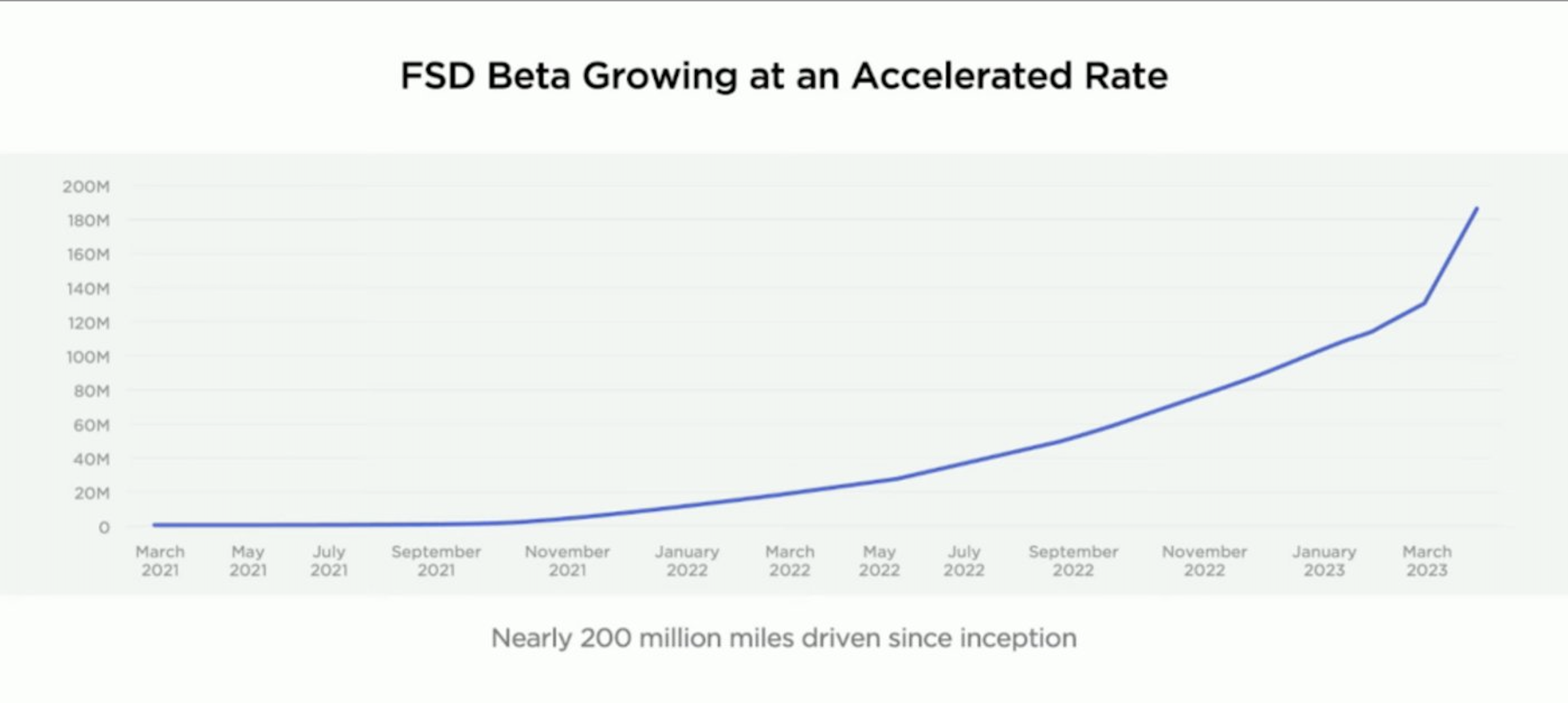
More crucially, FSD Beta is still far from the goal of “complete autonomous driving” mentioned by Musk during its continuous progress and iteration.
Moreover, unlike other products, in order for FSD to gradually come to fruition, it needs not only advancements and breakthroughs in technology but also the approval of regulatory agencies in various countries, including the United States. Musk has repeatedly mentioned in interviews: to test FSD Beta in Europe and other regions, approval from local traffic regulatory authorities is inevitably required.
Of course, this is also a hurdle for FSD’s implementation in China.
It is worth noting that since its release, FSD has already experienced more than two and a half years – however, in China’s highly competitive market, numerous Chinese automakers, including the likes of “NIO, XPeng, and LI Auto,” have already announced their own city NOA implementation plans, some even aiming to achieve specific targets within six months. Based on this, 2023 has even been dubbed the “inaugural year for urban NOA implementation”.
Their pace seems somewhat aggressive – compared to them, Tesla’s path to FSD implementation appears much more cautious.
After all, as a pioneer on the road to implementation, FSD has been in progress for more than two years, yet its current practical effects remain far from the ultimate goal. It continues to trek onwards while constantly reminding the entire industry:
The deployment of urban navigation assistance driving, as represented by FSD, should never be a matter of overnight success. On the path to autonomous driving, what automakers truly need is a down-to-earth approach, a step-by-step progression, continuous testing, iteration, and advancement.
This article is a translation by ChatGPT of a Chinese report from 42HOW. If you have any questions about it, please email bd@42how.com.
